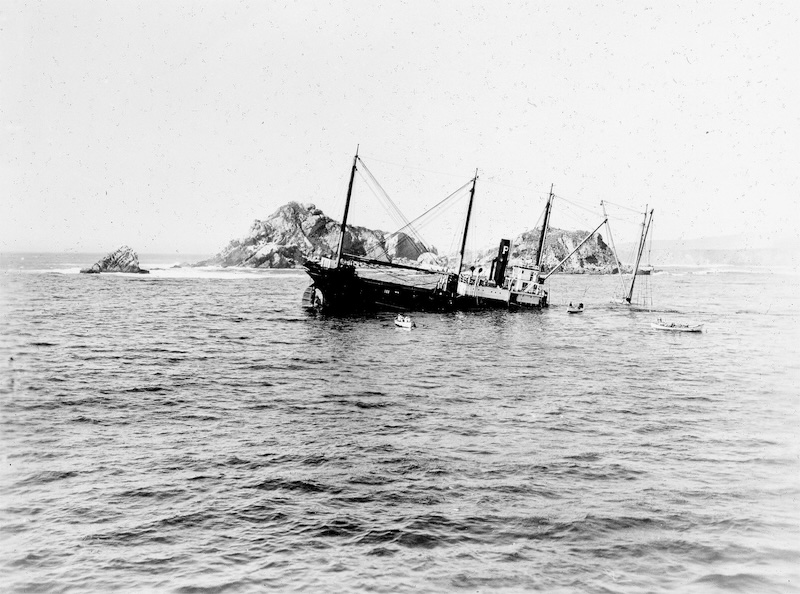While the Mendocino Coast has seen many shipwrecks along its shores, and enjoyed salvaging the cargo that washed up, the sinking of the “SS Dorothy Wintermote” in September of 1938 stands out in the memories of the locals. A veteran of Pacific coastal service, with more than 15 years of traffic on her record, the steamer was carrying a cargo of large appliances, gas cylinders, pharmacy drugs, and groceries from San Francisco to northern ports when she ran aground in heavy fog on Fish Rock near Anchor Bay on the morning of September 17th.

SS Dorothy Wintermote stranded at Fish Rock, California with the bow and forward cargo hold No. 1 submerged. The U.S. Coast Guard Cutter Shoshone’s lifeboats are standing by to render aid. (Courtesy of San Francisco Maritime Museum)
Built in 1918 in Toledo, Ohio, as a military ship, she was christened the “Lake Cayuga.” With the end of World War I, she was repurposed as a merchant vessel and renamed the “Dorothy Wintermote” after the daughter of the founder of the Puget Sound Lumber Company. At 251 feet long, the ship weighed 1,227 tons and had a carrying capacity of 1,800,000 board feet of timber. When not full of timber, her space was used to transport household goods and comestibles.
At 7:50 a.m., the “Dorothy Wintermote” radioed an SOS: she had two holes torn in her bow and was stranded on jagged rocks. For four days her crew made repairs and waited for aid. Most of the 27 crew members were taken off by the Coast Guard, but the captain and four crew remained. While a plan was being made to save the ship, local people had an opportunity to visit her.
In “Mendocino Coast Memories” (by the Yesteryears News Collective, 2003), South Coast old timer Norman Pierce reminisced about rowing out to the ship many times and looking down into the cavernous hold. As the waves churned through the hole cut into the hull, Pierce watched as drugs, corncob pipes, wine barrels, salad oil, and watches tumbled back and forth. His eyes were drawn to the many red cans of Hills Brothers coffee bobbing in the brine. The ship’s owner, Hammond Shipping Company, later reported the freight included 76,000 two-pound, four-pound, and 15-pound cans of the vacuum-packed coffee. Pierce collected about 3,000 of the cans floating in the surf, which he sold to the state hospital in Talmadge for 25 cents a pound. He also gathered a gunny sack full of watches, pipes, and shoestrings.
The Coast Guard arranged for the Red Stack sea tug “Sea Giant” to pull the ship off the rock and to tow her back to San Francisco. The seas were rough, however, and soon after the ship was freed, the bow was submerged. At that point, a life boat came to take Captain O. J. Olson and the crew members off. According to the September 22nd “San Francisco Examiner,” “The ship went down at the bow and then a bulkhead went, and after that, she was lost. It was only a question of minutes. Finally she stood on end, and slipped into the sea, in about 45 fathoms. The tug’s line was still attached and had to be pulled free from the sunken ship’s towing bitts by sheer power.”
A half-mile stretch of beach was littered with hundreds of red cans of coffee, and because the tide was high at the time, some of the cargo was washed up the Gualala River. Word had by now gotten out, so residents from miles around headed for the bounty. According to the “Ukiah Republican Press” of October 2, 1938, when Hills Brothers representative M. L. Meeker arrived on the scene a couple days later, much of the coffee was gone. He heard reports that local residents had gathered 2,000 to 3,000 pounds of the coffee.
Vernon McNamee remembered the Hills Brothers coffee and Crisco cans because he collected so many of them that they got him through much of World War II. “We had to use very little chicory as coffee stretcher,” he recalled happily. His neighbor, Mark Pedotti, attempted to bring a wine barrel from the beach up his bluff with a rope sling, but just as he got it to the top, the rope slipped and the barrel went “Blung, blung, crash, splash,” said McNamee. Pedotti wept.
Pedotti might have been the only local weeping. As to the vessel’s owners, the ship and cargo were lost, but both were fully insured.
The Kelley House Museum is open from 11AM to 3PM Thursday through Monday.